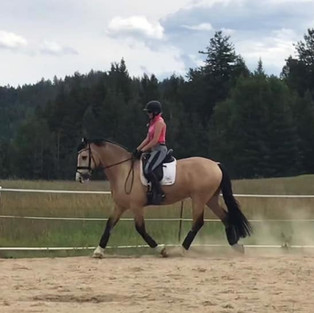Helping Friends With Their Horses
- Stef
- Aug 6, 2019
- 3 min read

A friend of mine called me the other day and asked if I would come spend a few days at her ranch in Idaho to help with her horses, since her husband was going fishing for a week. Of course I jumped at the idea of a girls weekend playing with horses, cooking, drinking wine and talking about horses non-stop.
I have been helping my friend Wendy with her riding since she was a kid, she reminded me of the summer I helped with her 15.2 hand paint mare when she was just 14 years old! The mare was trained as an all round pleasure show horse, and would jump almost anything at around 2 ft but one day when both of them were in one of my lessons, I ended up building the jump up to 4 ft and they jumped higher then she had ever imagined. That right there is why I love teaching. To be able to offer insight and help a rider and horse understand each other better, and then seeing that unity create a perfect moment that sets them both free. My teaching style is unique in that it stems from my understanding of balance and flow rather than resistance. l learned this skiing because I learned to ski with my parents before I could talk. And funny as it sounds riding is very much like skiing. Disasters can occur if your balance is off in both sports, you have to learn to let go, enjoy and channel the power you create not control it, as they say you can’t move a mountain.
When an equestrian sees a horse moving with graceful agility and strength, we wish to be a part of the power and elegance of their movement yet most times we end up getting in the horse's way. For this reason a lot of riders are “lesson junkies” always trying to learn more so that we can better understand how to communicate with our horse. But if we ride alone a lot it can get confusing, as the voice in a riders head reminding them of what they learned in their last lesson can often end up outdated. Horses are always changing (that's what happens when you do a sport where the "equipment" has a mind of its own). The training tip the rider may be focusing on is for the way the horse was going during the last lesson not necessarily today. Which is why it’s key to try and always improve the exercise or movement you’re doing rather than "fixing" your horse as you might end up working on the symptom to a problem not the root cause of it. Often people try to improve the horse's way of going by training them to react in a way that shows obedience. For example, if a horse balances itself through its back and hindquarters correctly it will relax its head downward. Instead of focusing on making your horse put their head down use schooling figures (circles, serpentines, diagonals, half turns, shoulder-in) and transitions to improve your horse’s balance and strength, then they will lower their head naturally and voluntarily.
On my trip to Idaho I was able to help my friend Wendy with all her horses and her friend Lisa on her horse by helping them find the right exercise to improve their horse's natural way of going. POOF ✨ everybody was happy. It was so nice to spend 4 days with such a great friend. Even though we come from completely different upbringings we have a lot of the same values so we can admire, understand, love, and banter about everything under the sun. We played horsey, cooked some great food and had endless conversations. Life (with horses) is good! 🤣













Comments